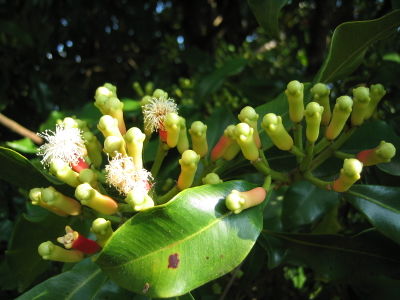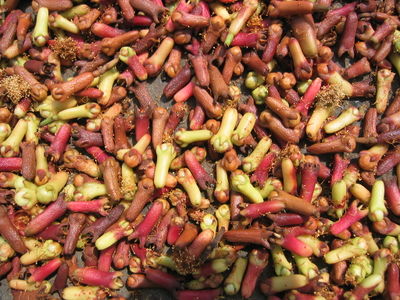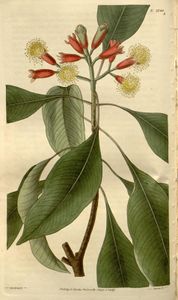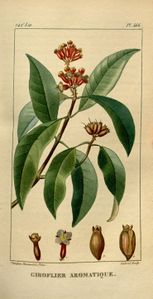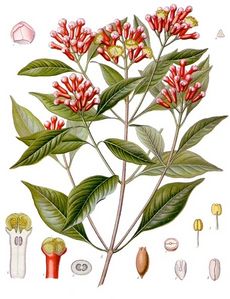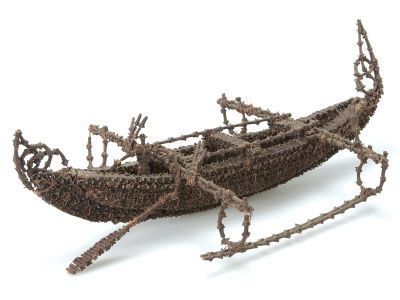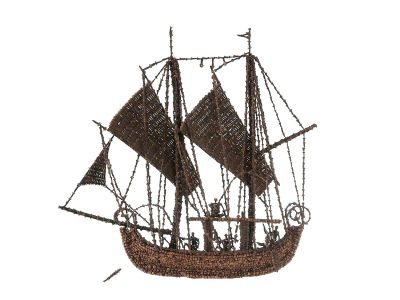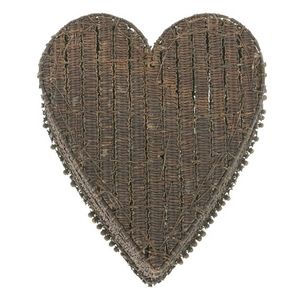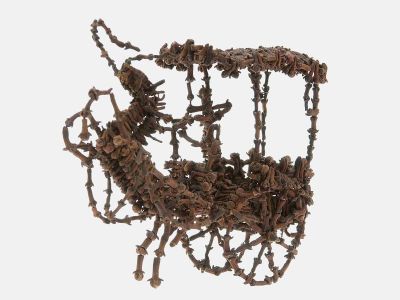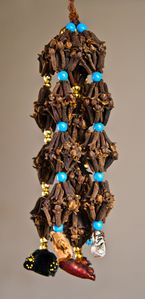Syzygium aromaticum : Différence entre versions
| (17 révisions intermédiaires par 2 utilisateurs non affichées) | |||
| Ligne 7 : | Ligne 7 : | ||
|genre = Syzygium | |genre = Syzygium | ||
|nb chromosomes = 2n = 22 | |nb chromosomes = 2n = 22 | ||
| − | |origine = | + | |origine = nord des Moluques, Nouvelle-Guinée |
|statut = sauvage ou cultivé | |statut = sauvage ou cultivé | ||
| + | |français = '''giroflier / clou de girofle''' | ||
| + | |anglais = '''clove''' | ||
| + | }}{{Encadré | ||
| + | |color=lightgreen | ||
| + | |titre=Résumé des usages | ||
| + | |texte=*clous fumés avec du tabac dans les cigarettes kretek | ||
| + | *eugénol distillé des clous ou des feuilles | ||
| + | *médicinal : clou et fruit | ||
| + | *anesthésique dentaire | ||
| + | *bois d'œuvre | ||
}} | }} | ||
| − | + | == Description == | |
| − | + | <gallery mode="packed"> | |
| − | + | File:Syzygium aromaticum PROSEA linedrawing.png|1, branches avec fleurs et boutons de fleurs ; 2, clou de girofle (PROSEA) | |
| − | + | ||
| − | == | + | |
| − | + | ||
| − | + | ||
| − | + | ||
| − | + | ||
| − | + | ||
| − | + | ||
| − | + | ||
| − | + | ||
| − | + | ||
| − | + | ||
| − | + | ||
| − | + | ||
| − | + | ||
| − | + | ||
| − | + | ||
| − | + | ||
| − | + | ||
| − | + | ||
| − | + | ||
| − | + | ||
| − | + | ||
| − | + | ||
| − | + | ||
| − | + | ||
| − | + | ||
| − | + | ||
| − | + | ||
| − | + | ||
| − | + | ||
| − | + | ||
File:Clove trees.JPG|arbre | File:Clove trees.JPG|arbre | ||
File:Starr 070906-8563 Syzygium aromaticum.jpg|feuilles | File:Starr 070906-8563 Syzygium aromaticum.jpg|feuilles | ||
| Ligne 50 : | Ligne 28 : | ||
File:Cloves fresh in hand.JPG|fleurs en bouton et défleuries | File:Cloves fresh in hand.JPG|fleurs en bouton et défleuries | ||
File:CloveCloseUp.jpg|clou de girofle | File:CloveCloseUp.jpg|clou de girofle | ||
| + | File:Syzygium aromaticum drying.jpg|clous de girofle juste récoltés | ||
File:Seasonal clove buds drying on Pemba1.jpg|séchage des clous de girofle sur l'île de Pemba | File:Seasonal clove buds drying on Pemba1.jpg|séchage des clous de girofle sur l'île de Pemba | ||
| + | File:Munduk Bali Syzygium aromaticum drying.jpg|séchage dans les rues à Bali | ||
</gallery> | </gallery> | ||
| + | |||
| + | == Noms populaires == | ||
| + | {| class="wikitable" style="width:100%;" | ||
| + | | français | ||
| + | | giroflier / clou de girofle | ||
| + | |- | ||
| + | | créole antillais | ||
| + | | jiwof, kloujiwof (TRAMIL) | ||
| + | |- | ||
| + | | anglais | ||
| + | | clove tree / clove | ||
| + | |- | ||
| + | | allemand | ||
| + | | Gewürznelkenbaum / Gewürznelke | ||
| + | |- | ||
| + | | néerlandais | ||
| + | | kruidnagelboom / kruidnagel | ||
| + | |- | ||
| + | | italien | ||
| + | | chiodo di garofano | ||
| + | |- | ||
| + | | portugais | ||
| + | | cravo da Índia, cravo aromático | ||
| + | |- | ||
| + | | espagnol | ||
| + | | clavero, árbol del clavo / clavo de olor, clavo dulce | ||
| + | |- | ||
| + | | turc | ||
| + | | karanfil | ||
| + | |- | ||
| + | | arabe | ||
| + | | قَرُنْفُل ,قَرَنْفُل - qarunfil, qaranful | ||
| + | |- | ||
| + | | sanscrit | ||
| + | | lavaṃga ; lavaṃgkusuma ("fleur" de lavaṃga) ; lavaṃgakalikā "bouton de fleur de lavaṃga" | ||
| + | |- | ||
| + | | hindi | ||
| + | | laung (Wealth of India) ; लौंग | ||
| + | |- | ||
| + | | bengali | ||
| + | | laung (Wealth of India) | ||
| + | |- | ||
| + | | gujerati | ||
| + | | laung (Wealth of India) | ||
| + | |- | ||
| + | | marathi | ||
| + | | laung (Wealth of India) | ||
| + | |- | ||
| + | | telugu | ||
| + | | lavangamuchettu (arbre) ; lavangamulu (clous) (Wealth of India) | ||
| + | |- | ||
| + | | tamoul | ||
| + | | kirambu (Wealth of India) ; கராம்பு, கிராம்பு | ||
| + | |- | ||
| + | | kannada | ||
| + | | lavanga (Wealth of India) | ||
| + | |- | ||
| + | | malayalam | ||
| + | | karayampu, krambu (Wealth of India) | ||
| + | |- | ||
| + | | Indonésie | ||
| + | | cengkeh (PROSEA) | ||
| + | |- | ||
| + | | Malaysia | ||
| + | | chengkeh, chingkeh (PROSEA) | ||
| + | |- | ||
| + | | Philippines | ||
| + | | klabong pako, clavo de comer (PROSEA) | ||
| + | |- | ||
| + | | Birmanie | ||
| + | | lay-hnyin (PROSEA) | ||
| + | |- | ||
| + | | Cambodge | ||
| + | | khan phluu, khlam puu (PROSEA) | ||
| + | |- | ||
| + | | Laos | ||
| + | | do:k chan, ka:nz ph'u (PROSEA) | ||
| + | |- | ||
| + | | Thaïlande | ||
| + | | kanphlu (PROSEA) | ||
| + | |- | ||
| + | | Vietnam | ||
| + | | dinh hương (PROSEA) | ||
| + | |} | ||
| + | *Voir l'étymologie de [[Etymologie des noms scientifiques#Caryophyllus|''Caryophyllus'']] et [[Etymologie des noms populaires#Caryophyllus|girofle]] | ||
== Classification == | == Classification == | ||
| Ligne 67 : | Ligne 132 : | ||
== Histoire == | == Histoire == | ||
| − | <gallery | + | <gallery mode="packed"> |
| + | File:Curtis's botanical magazine (Plate 2749) (8611143890).jpg|''Curtis's botanical magazine'', pl. 2749, 1827 | ||
| + | File:Curtis's botanical magazine (Plate 2750) (8610039221).jpg|''Curtis's botanical magazine'', pl. 2750, 1827 | ||
| + | File:Flore médicale des Antilles, ou, Traité des plantes usuelles (10559035544).jpg|Giroflier aromatique, Descourtilz, ''Flore médicale des Antilles'', 1829, 8:566 | ||
File:Syzygium aromaticum - Köhler–s Medizinal-Pflanzen-030.jpg|Köhler, 1897. ''Medizinal-Pflanzen'' | File:Syzygium aromaticum - Köhler–s Medizinal-Pflanzen-030.jpg|Köhler, 1897. ''Medizinal-Pflanzen'' | ||
| − | |||
| − | |||
File:Stamps of Indonesia, 047-10.jpg|timbre indonésien de 2010 | File:Stamps of Indonesia, 047-10.jpg|timbre indonésien de 2010 | ||
</gallery> | </gallery> | ||
== Usages == | == Usages == | ||
| − | <gallery | + | <gallery mode="packed"> |
File:COLLECTIE TROPENMUSEUM Kruidnagelmodel van een vlerkprauw TMnr 63-1.jpg|modèle de bateau en clous de girofle (Indonésie, Tropenmuseum) | File:COLLECTIE TROPENMUSEUM Kruidnagelmodel van een vlerkprauw TMnr 63-1.jpg|modèle de bateau en clous de girofle (Indonésie, Tropenmuseum) | ||
File:COLLECTIE TROPENMUSEUM Kruidnagelmodel van een zeilprauw TMnr 4955-1.jpg|modèle de bateau en clous de girofle (Indonésie, Tropenmuseum) | File:COLLECTIE TROPENMUSEUM Kruidnagelmodel van een zeilprauw TMnr 4955-1.jpg|modèle de bateau en clous de girofle (Indonésie, Tropenmuseum) | ||
| Ligne 83 : | Ligne 149 : | ||
File:Orange pomander.jpg|pomme de senteur | File:Orange pomander.jpg|pomme de senteur | ||
</gallery> | </gallery> | ||
| + | {{Citation encadré | ||
| + | |texte=Probably cultivated for more than 2.000 years. During the Han dynasty (220-200 BC) already well-known and used in S China. Nowadays planted (besides Indonesia as largest producer and consumer) mainly in Tanzania (Zanzibar, Pemba), Madagascar, Malaysia and Sri Lanka; also in S India, Réunion, the Comores, Gabon, French Guayana, Martinique, Dominica and Jamaica. The cloves of commerce are flower buds, harvested, when the calyx begins to redden. They are used whole, or variously grinded as spice or for the production of clove oil, obtained by distillation of the dried flower buds, peduncles or leaves. The main component of this oil is eugenol, one of the 12 most frequently produced etheric oils. It has great importance in the pharmaceutical and perfume industry, also in microscopy and medicine; formerly also used to synthetize vanillin. Most of the cloves are used for the production of the Kretek cigarettes in Indonesia; which are composed of ground cloves (about 30%) and tobacco (70%). | ||
| + | |auteur =Mansfeld. | ||
| + | }} | ||
== Références == | == Références == | ||
| − | *Deinum, H., 1949. De kruidnagel | + | *Deinum, H., 1949. De kruidnagel. In: van Hall, C.J.J. & van de Koppel, C. (Editors): ''De landbouw in de Indischen Archipel'' [L'agriculture dans l'archipel indonésien]. Vol. 2B. van Hoeve, 's-Gravenhage, the Netherlands. p. 684-719. |
| − | *de Waard, P.W.F., 1974. The development of clove buds and causes of irregular bearing of cloves (''Eugenia caryophyllus'' (Sprengel) Bullock et Horrison). ''Journal of Plantation Crops'', 2(2): 23-31. | + | *de Waard, P.W.F., 1974. The development of clove buds and causes of irregular bearing of cloves (''Eugenia caryophyllus'' (Sprengel) Bullock et Horrison). ''Journal of Plantation Crops'', '''2'''(2): 23-31. |
*Dufournet, R., 1968. Le giroflier et sa culture à Madagascar. ''Bulletin of Madagascar'', 18: 216-281. | *Dufournet, R., 1968. Le giroflier et sa culture à Madagascar. ''Bulletin of Madagascar'', 18: 216-281. | ||
| − | *Purseglove, J.W., Brown, E.G., Green, C.L. & Robbins, S.R.J., 1981. ''Spices''. Vol. 2. Longman, Harlow, Essex, United Kingdom. | + | *Purseglove, J.W., Brown, E.G., Green, C.L. & Robbins, S.R.J., 1981. ''Spices''. Vol. 2. Longman, Harlow, Essex, United Kingdom. p. 229-285. |
| − | *Tidbury, G.E., 1949. ''The clove tree''. Crosby Lockwood & Son, London, United Kingdom. 212 | + | *Rollet, Bernard et coll., 2010. ''Arbres des Petites Antilles''. Tome 1 : ''Introduction à la dendrologie''. 276 p. Tome 2 : ''Description des espèces''. 866 p. + 46 pl. coul. + CD de photos sur l'anatomie du bois. Basse-Terre, ONF. Voir [[Syzygium aromaticum (Rollet, Antilles)|sur Pl@ntUse]]. |
| − | *Weiss, E.A., 1997. ''Essential oil crops''. CAB International, Wallingford, Oxon, United Kingdom. | + | *Tidbury, G.E., 1949. ''The clove tree''. Crosby Lockwood & Son, London, United Kingdom. 212 p. |
| − | *Wit, F., 1969. The clove tree ''Eugenia caryophyllus'' (Sprengel) Bullock & Harrison. In: Ferwerda, F.P. & Wit, F. (Editors): ''Outlines of perennial crop breeding in the tropics''. Miscellaneous Papers No 4, Wageningen Agricultural University, Wageningen, the Netherlands. | + | *TRAMIL, ''Pharmacopée végétale caribéenne'', éd. scient. L. Germosén-Robineau. 2014. 3e éd. Santo Domingo, Canopé de Guadeloupe. 420 p. Voir sur [[Syzygium aromaticum (TRAMIL)|Pl@ntUse]] |
| + | *Weiss, E.A., 1997. ''Essential oil crops''. CAB International, Wallingford, Oxon, United Kingdom. p. 235-259. | ||
| + | *Wit, F., 1969. The clove tree ''Eugenia caryophyllus'' (Sprengel) Bullock & Harrison. In: Ferwerda, F.P. & Wit, F. (Editors): ''Outlines of perennial crop breeding in the tropics''. Miscellaneous Papers No 4, Wageningen Agricultural University, Wageningen, the Netherlands. p. 163-174. | ||
== Liens == | == Liens == | ||
*[http://www.biodiversitylibrary.org/search.aspx?SearchTerm=Syzygium%20aromaticum&SearchCat= BHL] | *[http://www.biodiversitylibrary.org/search.aspx?SearchTerm=Syzygium%20aromaticum&SearchCat= BHL] | ||
*[http://ecocrop.fao.org/ecocrop/srv/en/cropView?id=2462 FAO Ecocrop] | *[http://ecocrop.fao.org/ecocrop/srv/en/cropView?id=2462 FAO Ecocrop] | ||
| − | *[http://gernot-katzers-spice-pages.com/engl/Syzy_aro.html | + | *[http://gernot-katzers-spice-pages.com/engl/Syzy_aro.html Gernot Katzer's Spice pages] |
*[http://botanical.com/botanical/mgmh/c/cloves76.html Grieve's herbal] | *[http://botanical.com/botanical/mgmh/c/cloves76.html Grieve's herbal] | ||
| − | *[ | + | *[https://npgsweb.ars-grin.gov/gringlobal/taxonomydetail.aspx?id=50069 GRIN] |
*[http://www.ipni.org/ipni/simplePlantNameSearch.do?find_wholeName=Syzygium%20aromaticum&output_format=normal&query_type=by_query&back_page=query_ipni.html IPNI] | *[http://www.ipni.org/ipni/simplePlantNameSearch.do?find_wholeName=Syzygium%20aromaticum&output_format=normal&query_type=by_query&back_page=query_ipni.html IPNI] | ||
| − | *[http://mansfeld.ipk-gatersleben.de/ | + | *[http://mansfeld.ipk-gatersleben.de/apex/f?p=185:46:3908405078932::NO::module,mf_use,source,akzanz,rehm,akzname,taxid:mf,,botnam,0,,Syzygium%20aromaticum,12338 Mansfeld] |
*[http://www.plantnames.unimelb.edu.au/Sorting/Syzygium.html Multilingual Plant Name Database] | *[http://www.plantnames.unimelb.edu.au/Sorting/Syzygium.html Multilingual Plant Name Database] | ||
*[https://hort.purdue.edu/newcrop/Crops/Clove.html NewCrop Purdue] | *[https://hort.purdue.edu/newcrop/Crops/Clove.html NewCrop Purdue] | ||
*[http://www.theplantlist.org/tpl1.1/search?q=Syzygium+aromaticum Plant List] | *[http://www.theplantlist.org/tpl1.1/search?q=Syzygium+aromaticum Plant List] | ||
| − | *[ | + | *[[:en:Syzygium aromaticum (PROSEA)|PROSEA sur Pl@ntUse]] |
| − | + | *[https://inpn.mnhn.fr/espece/cd_nom/630768/tab/taxo TAXREF] | |
| − | *[ | + | |
| − | + | ||
| − | + | ||
*[http://tropical.theferns.info/viewtropical.php?id=Syzygium%20aromaticum Useful Tropical Plants Database] | *[http://tropical.theferns.info/viewtropical.php?id=Syzygium%20aromaticum Useful Tropical Plants Database] | ||
*[https://fr.wikipedia.org/wiki/Syzygium%20aromaticum Wikipédia] | *[https://fr.wikipedia.org/wiki/Syzygium%20aromaticum Wikipédia] | ||
Version actuelle en date du 24 juillet 2021 à 20:32
Syzygium aromaticum
(L.) Merr. & L. M. Perry
| Ordre | Myrtales |
|---|---|
| Famille | Myrtaceae |
| Genre | Syzygium |
2n = 22
Origine : nord des Moluques, Nouvelle-Guinée
sauvage ou cultivé
| Français | giroflier / clou de girofle |
|---|---|
| Anglais | clove |
- clous fumés avec du tabac dans les cigarettes kretek
- eugénol distillé des clous ou des feuilles
- médicinal : clou et fruit
- anesthésique dentaire
- bois d'œuvre
Sommaire
Description
Noms populaires
| français | giroflier / clou de girofle |
| créole antillais | jiwof, kloujiwof (TRAMIL) |
| anglais | clove tree / clove |
| allemand | Gewürznelkenbaum / Gewürznelke |
| néerlandais | kruidnagelboom / kruidnagel |
| italien | chiodo di garofano |
| portugais | cravo da Índia, cravo aromático |
| espagnol | clavero, árbol del clavo / clavo de olor, clavo dulce |
| turc | karanfil |
| arabe | قَرُنْفُل ,قَرَنْفُل - qarunfil, qaranful |
| sanscrit | lavaṃga ; lavaṃgkusuma ("fleur" de lavaṃga) ; lavaṃgakalikā "bouton de fleur de lavaṃga" |
| hindi | laung (Wealth of India) ; लौंग |
| bengali | laung (Wealth of India) |
| gujerati | laung (Wealth of India) |
| marathi | laung (Wealth of India) |
| telugu | lavangamuchettu (arbre) ; lavangamulu (clous) (Wealth of India) |
| tamoul | kirambu (Wealth of India) ; கராம்பு, கிராம்பு |
| kannada | lavanga (Wealth of India) |
| malayalam | karayampu, krambu (Wealth of India) |
| Indonésie | cengkeh (PROSEA) |
| Malaysia | chengkeh, chingkeh (PROSEA) |
| Philippines | klabong pako, clavo de comer (PROSEA) |
| Birmanie | lay-hnyin (PROSEA) |
| Cambodge | khan phluu, khlam puu (PROSEA) |
| Laos | do:k chan, ka:nz ph'u (PROSEA) |
| Thaïlande | kanphlu (PROSEA) |
| Vietnam | dinh hương (PROSEA) |
- Voir l'étymologie de Caryophyllus et girofle
Classification
Syzygium aromaticum (L.) Merr. & L. M. Perry (1939)
basionyme :
- Caryophyllus aromaticus L. (1753)
synonymes :
- Eugenia caryophyllata Thunb. (1800)
- Eugenia aromatica (L.) Baill. (1876)
- Eugenia caryophyllus (Sprengel) Bullock & Harrison (1958)
Cultivars
Histoire
Usages
Probably cultivated for more than 2.000 years. During the Han dynasty (220-200 BC) already well-known and used in S China. Nowadays planted (besides Indonesia as largest producer and consumer) mainly in Tanzania (Zanzibar, Pemba), Madagascar, Malaysia and Sri Lanka; also in S India, Réunion, the Comores, Gabon, French Guayana, Martinique, Dominica and Jamaica. The cloves of commerce are flower buds, harvested, when the calyx begins to redden. They are used whole, or variously grinded as spice or for the production of clove oil, obtained by distillation of the dried flower buds, peduncles or leaves. The main component of this oil is eugenol, one of the 12 most frequently produced etheric oils. It has great importance in the pharmaceutical and perfume industry, also in microscopy and medicine; formerly also used to synthetize vanillin. Most of the cloves are used for the production of the Kretek cigarettes in Indonesia; which are composed of ground cloves (about 30%) and tobacco (70%).
Références
- Deinum, H., 1949. De kruidnagel. In: van Hall, C.J.J. & van de Koppel, C. (Editors): De landbouw in de Indischen Archipel [L'agriculture dans l'archipel indonésien]. Vol. 2B. van Hoeve, 's-Gravenhage, the Netherlands. p. 684-719.
- de Waard, P.W.F., 1974. The development of clove buds and causes of irregular bearing of cloves (Eugenia caryophyllus (Sprengel) Bullock et Horrison). Journal of Plantation Crops, 2(2): 23-31.
- Dufournet, R., 1968. Le giroflier et sa culture à Madagascar. Bulletin of Madagascar, 18: 216-281.
- Purseglove, J.W., Brown, E.G., Green, C.L. & Robbins, S.R.J., 1981. Spices. Vol. 2. Longman, Harlow, Essex, United Kingdom. p. 229-285.
- Rollet, Bernard et coll., 2010. Arbres des Petites Antilles. Tome 1 : Introduction à la dendrologie. 276 p. Tome 2 : Description des espèces. 866 p. + 46 pl. coul. + CD de photos sur l'anatomie du bois. Basse-Terre, ONF. Voir sur Pl@ntUse.
- Tidbury, G.E., 1949. The clove tree. Crosby Lockwood & Son, London, United Kingdom. 212 p.
- TRAMIL, Pharmacopée végétale caribéenne, éd. scient. L. Germosén-Robineau. 2014. 3e éd. Santo Domingo, Canopé de Guadeloupe. 420 p. Voir sur Pl@ntUse
- Weiss, E.A., 1997. Essential oil crops. CAB International, Wallingford, Oxon, United Kingdom. p. 235-259.
- Wit, F., 1969. The clove tree Eugenia caryophyllus (Sprengel) Bullock & Harrison. In: Ferwerda, F.P. & Wit, F. (Editors): Outlines of perennial crop breeding in the tropics. Miscellaneous Papers No 4, Wageningen Agricultural University, Wageningen, the Netherlands. p. 163-174.



